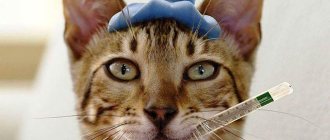Save the article:
If you stroke any purr, it will seem that the cat’s body temperature is slightly higher than that of a person. For pets, indicators that exceed human values by several degrees are the norm. The parameters of a cat's temperature are discussed somewhat differently than those of humans. But an increase or decrease in normal values may signal the occurrence of some processes that indicate a pet’s illness.
Temperature in cats
There are a number of features to determine the normal body temperature of cats. The normal body temperature of cats, kittens, young cats and old cats is different.
The body temperature of newborn kittens does not differ from that of the mother.
- Only until the third week can body temperature change from 35.5 to 36.5 and this is normal, thermoregulation is still developing, so the temperature changes.
- After three weeks, kittens’ body temperature increases significantly from 38.5 to 39.5.
You should not worry about such indicators; they are normal for a growing organism, because the kitten is actively learning about the world around it; everyone knows that the manifestation of energy is accompanied by an increase in temperature.
Let's figure out what is a cat's normal temperature. Body temperature for adults may vary depending on the size and weight of your pet. A larger organism requires more energy and therefore produces more heat.
- The norm for adult cats is a temperature of 37.5 d 38.9.
- The normal temperature for British cats is no different from the temperatures listed above.
- The normal temperature in Maine Coon cats is slightly different due to their large body weight, ranging from 38 to 39.5.
- If your pet's body temperature exceeds the normal level by more than one degree (from 1.2), you should contact a veterinarian.
The most dangerous indicators of your pets’ body temperature are a decrease to 37 degrees and an increase to 40.
The body temperature of cats does not depend on the amount of fur. That is, the body temperature of a sphinx is the same as that of an ordinary cat. The owners of this breed feel the body temperature of cats much better due to the lack of fur.
Causes of fever in cats
Not in all cases, an increase in temperature indicates the onset of the disease. The temperature may vary depending on the pet's activity and time of day. Deviations of 0.5 and 1 degree are read as normal.
An increase in temperature may be due to the following factors:
- The cause of the increase in temperature may be a vaccination or previous surgery. The body has been stressed or the immune system is being restored; an increase in temperature on this basis can last up to three days. If the temperature does not subside for longer, you should contact a veterinarian;
- Stress. For your pets, a seemingly ordinary trip or a visit to the veterinary clinic can become stressful. Pets may experience stress from the appearance of new animals in the house or a stranger;
- Medicines. If you add medicinal drugs to your pet's food, they may also cause the temperature to rise. You, in turn, should check with your veterinarian whether the drug causes an increase in temperature in the cat;
- Games. As previously mentioned, your pet consumes a lot of energy during play, which is accompanied by an increase in body temperature;
- Pregnancy. Since the cat’s body needs to provide warmth not only for itself, but also for the kittens. An increase in body temperature is also possible;
- Feeding kittens. The cat needs to consume more food; when food is broken down, it releases additional heat;
Room temperature. For naive kittens, you need a room whose temperature is 31 degrees, otherwise the kitten’s temperature can rise above 40 degrees in order to provide the body with warmth.
After 3 weeks, kittens can be placed in a room whose temperature will be 24 degrees, therefore, their body temperature will return to normal.
Actions in case of deviation from the norm
An attentive owner will always understand that something wrong is happening to the cat: external signs that differ in hyper- and hypothermia will tell him about it.
At reduced temperatures the following are noted:
- bradycardia;
- decreased activity and lethargy;
- hypotension;
- blanching of mucous membranes;
- slow breathing, sharp inhalation/exhalation.
- trying to find a warm place.
At elevated temperatures the following are observed:
- tachycardia;
- chills and fever;
- loss of appetite and refusal to drink water;
- drowsiness and apathy;
- dehydration (with prolonged fever);
- diarrhea and/or vomiting with a bad smell (in severe cases).
In general, you should be wary of any deviations from the temperature norm, as they can signal various diseases, sometimes very serious ones.
If the elevated temperature
An increase in temperature can be caused by both diseases and other (non-physiological factors):
- viral diseases - cats usually have distemper (panleukopenia), calicivirus, rhinotracheitis and coronavirus;
- inflammatory processes - often occur when wounds or postoperative sutures become infected;
- overheating - kittens, old and weakened cats that are forced to stay in the heat for a long time, for example, in a car or in a stuffy room, often suffer from it;
- stress often provokes a failure of thermoregulation. The reasons may be a trip in transport, a visit to the veterinarian, a change of owner or place of residence.
This is interesting! The temperature often rises by about 1 degree after vaccination, when the body produces antibodies against viruses, or sterilization (as a reaction to surgery).
Actions at elevated temperatures
If going to the vet is not possible, use the following methods to reduce the fever:
- humidify the air in the room;
- give the cat cool water (if it refuses, drink it from a syringe without a needle or pipette);
- moisten exposed skin with water;
- wrap in a wet towel;
- Place ice behind your ears, neck, or inner thighs.
Self-treatment, especially with the use of drugs developed for the human body, is not allowed. Antibiotics and antipyretics can negatively affect the cat’s body, causing allergies or liver/kidney problems.
If the low temperature
The reasons for a drop in temperature in a cat are internal pathologies and external factors, such as:
- exhaustion and loss of strength caused by chronic malnutrition;
- viral infections (against the background of weakened immunity);
- dysfunction of internal organs (heart and blood vessels, endocrine system, liver and kidneys);
- blood loss that occurs after injuries and operations (internal bleeding is especially dangerous, which the owners do not notice immediately):
- helminthiasis – infection with parasites leads to exhaustion, anemia and impaired thermoregulation.
But the most common cause of a drop in temperature is hypothermia, which occurs after a cat has been in the cold for a long time.
Actions at low temperatures
If hypothermia is caused by hypothermia, your pet needs to be warmed up quickly:
- wrap in a blanket/plaid;
- place in a warm, wind-free place;
- give warm liquid to drink (you can use a pipette);
- Cover with heating pads or hot water bottles.
If your efforts are ineffective, take the cat to the hospital. There, most likely, she will be given a warm enema and put on a drip with saline solution.
Return to content
Decreased temperature in cats
- Exhaustion. For cats, not only excess food is dangerous, but also its lack. An organism that does not consume enough food is susceptible to infections that can cause a drop in temperature;
- Hypothermia. If the cat gets wet and you let him out into the cold or wind, you expose his body to hypothermia since the fur cannot perform the function of maintaining temperature. Even a hairless cat will not be exposed to hypothermia like a wet cat;
- Dream. During sleep, the body enters a state of rest, the internal processes of the body slow down and do not release much energy. It takes a short amount of time to restore normal body temperature;
- Childbirth. Before giving birth, cats may have a temperature drop of 1 degree. And the temperature rise after them. Body temperature returns to normal after a short amount of time. The reason for contacting a veterinarian may be a decrease in temperature over a long period of time;
- Anesthesia. Under anesthesia, the internal processes of the body slow down, accompanied by a decrease in temperature;
- Times of Day. The peak activity of cats occurs in the dark, hence the increase in body temperature. Your pet will have the lowest readings in the morning.
How to measure a cat's temperature
A rectal thermometer is used to measure body temperature in cats. It must be purchased at a pet store or veterinary pharmacies. Thermometers for people pose a direct danger to pets.
The normal temperature in a cat's anus is from 37.5 to 38.9 degrees.
- It takes at least two people to measure a cat's temperature using a rectal thermometer. You can harm your pet on your own, because he will break out;
- You can shoot the device with alcohol and smear it with Vaseline;
- The pet must be placed, laid down or wrapped in thick cloth to avoid scratches and bites. Place one hand under the cat's belly and the other on the neck to support the head;
- Treat the cat's anus with greasy cream or Vaseline;
- Lift the tail and insert the metal or rubber tip of the thermometer using spiral movements. For adult cats, it is necessary to insert 1-2 cm of the tip. For kittens the norm is 0.5-1 cm;
- Time 3 minutes or wait for the thermometer signal;
- After use, sterilize the thermometer with alcohol.
You can also use an ear thermometer to measure the temperature of cats; it is easy to use, but errors may occur if the pet’s ears are inflamed.
If the temperature is higher than normal
An elevated temperature in a cat may indicate a bacterial or viral disease or some kind of inflammatory process. The most common cat infections are:
- Panleukopenia (popularly “feline distemper”) is a dangerous disease caused by parvovirus, related to viral enteritis of dogs and minks. The virus affects the respiratory organs, gastrointestinal tract, causing severe fever, dehydration, intoxication, and death. Symptoms: loss of appetite, lethargy, yellowish vomit, diarrhea with a strong foul odor. The temperature rises to 40°C and above, the animal may fall into a coma. Small kittens, elderly and weakened animals are especially at risk. The high lethality of the virus is a consequence of a very short incubation period (2-10 days), high infectiousness (the virus begins to be excreted from the patient’s body in vomit and feces from the first days after infection), widespread prevalence and survivability (in the external environment it can persist for up to a year, resistant to temperature influences and weak antiseptics).
- Rhinotracheitis, or herpesvirus. It affects the mucous membranes of the eyes and respiratory tract, causes conjunctivitis, runny nose, fever, pneumonia; in advanced cases, it leaves complications on the respiratory organs and can cause complete loss of vision - eyeballs affected by herpes must be surgically removed. Symptoms of the disease: sneezing, coughing, purulent discharge from the eyes, lethargy, apathy, loss of appetite, temperature up to 40°C, sometimes vomiting with mucus. It is transmitted by airborne droplets, when using a common tray and bowls, through secretions - saliva, tears, urine, feces, seminal fluid. The incubation period is 3-8 days. In the external environment, the virus is unstable: when the secretions of a sick animal dry out, it dies. However, its particular danger lies in its long-term asymptomatic carriage and ability to integrate into the body at the cellular level - most cats that have had rhinotracheitis never completely get rid of the virus. Stress and weakened immunity can cause an exacerbation of the disease.
- Calcivirosis. It affects the mucous membranes of the eyes and respiratory tract; characteristic distinguishing signs are ulcers on the tongue and palate, and excessive salivation. Symptoms: nasal and eye discharge, sneezing, fever, lethargy, loss of appetite, in the initial stages - pallor of the mucous membranes, on which specific calciviral ulcers appear as the disease progresses. When the disease is advanced, laryngitis, bronchitis, pneumonia, anemia, anorexia, necrosis of the mucous membranes develop, and the animal may lose part of its tongue. Infection occurs through secretions from mucous membranes, urine and feces, the incubation period is 1-3 days, mortality is up to 30%. In the external environment, the virus persists for up to 10 days in the presence of humidity; when dry, it lives for 2-3 days. Relatively resistant to temperature influences and weak antiseptics.
- Coronavirus. One of the most dangerous, little-studied cat viruses. A distinctive feature of this virus is that in 80% of cases, carriage is asymptomatic, and the disease is caused by mutation of this virus into a fatal form. There is no clear answer about the causes of this mutation. The mutated virus infects the animal's intestines, causing inflammation that can develop into enteritis or peritonitis. Symptoms: diarrhea (stool becomes greenish-brown), vomiting, apathy, loss of appetite, anemic pallor of the mucous membranes. The development of peritonitis is accompanied by a strong increase in temperature and accumulation of fluid in the abdominal and chest cavity. Infection occurs primarily through the feces of a sick animal. At the same time, there are versions that up to 90% of all cats are affected by coronavirus (regular, not mutated). Until recently considered an “aristocratic” kennel disease, it is increasingly being found in stray animals.
The best way to protect against the first three groups of viruses is timely vaccination with a polyvalent vaccine. There is currently no generally accepted vaccine against coronavirus, although development is underway.
How to lower your temperature yourself
If your cat's temperature rises, you should contact a veterinarian; if you don't have the opportunity, try to bring down the temperature yourself. If you notice a slight change in your pet's temperature, re-measure a little later.
If the thermometer reads 40 degrees, contact your veterinarian.
- Perhaps your pet has overheated, place it in a cool room, provide access to fresh air;
- Lightly dampen the fur or wrap your pet in a damp towel;
- Don't let your body become dehydrated. Give your cat water from a syringe.
- Wet the llama's pads with a solution of water and vinegar, ratio 1 to 3.
Symptoms and first aid
You notice that your cat's nose is dry and hot to the touch - this is a signal of hyperthermia. The exception is elderly individuals whose cooling glands function poorly.
When the temperature rises, the pet may experience a feeling of weakness, move sluggishly, or not get up from its place. The pulse quickens, breathing becomes heavy and intermittent. Perhaps the animal will tremble, and a film in the form of a third eyelid will form on the eyeball.
With hyperthermia, the animal often refuses to eat and drinks almost no liquid, which can lead to dehydration. If many symptoms are present, the pet needs urgent treatment and your help.
A decrease in temperature in cats manifests itself in the following symptoms:
- trying to snuggle closer to the warmth;
- convulsive movements, fever;
- apathy, depressed state;
- pallor of the mucous membrane;
- tousled hair.
Providing first aid to an animal begins with the need to lay it on a level place and wrap it in a warm blanket. It is advisable to give plenty of fluids, but do not feed for several hours.
It is recommended to give your pet an alcoholic drink in small doses. You can pour one or two ml of vodka or diluted alcohol down his throat using a syringe to destroy germs. If you notice that there is no improvement, contact your doctor.
In case of hyperthermia (high temperature), the cat is taken to the veterinarian; if you can’t show your pet to a doctor, bring down the fever by at least tenths of a degree.
The condition can be alleviated by the following actions:
- increase indoor air humidity;
- moisten the wool with water or wrap it in a wet towel;
- put ice on the inside of the thighs, neck or behind the ears;
- drink cool water; if the pet refuses, use a pipette or syringe without a needle.
It is not allowed to treat the cat on your own or give medications. “Human” antipyretics and antibiotics cause kidney problems.
In case of hypothermia (low temperature) due to hypothermia, the pet is warmed up:
- placed in a warm place without a draft;
- wrapped in a blanket;
- cover with heating pads or containers with hot water;
- give a warm drink using a pipette.
If these measures do not help, the pet is taken to the clinic. There they give a warm enema and a drip with heated saline. If the cat is not hypothermic, but the temperature drops, the animal is wrapped up and taken to the doctor.
Temperature deviation from the norm is a clinical symptom of a host of diseases that only a doctor can identify and cure. The task of the cat owner is to find out the normal parameters of the pet, to recognize dangerous changes in external symptoms in time, to be able to measure and competently help.
Low temperature in a cat











